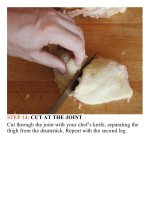The food lab better home cooking through science ( PDFDrive ) 800
Bạn đang xem bản rút gọn của tài liệu. Xem và tải ngay bản đầy đủ của tài liệu tại đây (233.21 KB, 2 trang )
ULTRA-CRISPROASTPORK
SHOULDER
Porkshoulderistheleadofculinaryalchemists,just
waiting,itchingtobeturnedintogold.
We’re talking pork butt, in all of its juicy, porky, spoontender-in-the-middle, impossibly crisp-and-crusty-on-theoutside glory. The transformation of one of the cheapest
cuts of meat in the butcher’s display case into one of the
most glorious, festive centerpieces imaginable is nothing
short of a miracle. At least, it would be if we believed in
suchthings.Butwe’rehereforthescienceofit,right?What
makes pork get tender, how do we maximize that
tenderness, and above all, how do we get the crisp,
cracklingskinthateveryonefightsover?
Afullbone-inBostonbuttisaformidablepieceofmeat,
usuallyweighinginataround8to12pounds,riddledwitha
significant amount of connective tissue and inter/intramuscular fat, all swathed in a thick, tough skin. Our
goal is to make this tough piece of meat spoonably tender.
How do you do that?Well, first we need to understand the
difference between the two major types of muscles in an
animal.
Fast-twitchmuscleisthestuffthattheanimalrarelyuses,
except in short bursts: The breasts on a chicken that let it
flapitswingsrapidlywhenescapingdanger.Theloinsona
cow that, well, barely get used at all. Fast-twitch muscle is
characterized by tenderness (think chicken breast, pork
chops,andNewYorkstripsteaks)andafine-texturedgrain
and is best prepared using fast-cooking methods like
roasting, grilling, or sautéing (see Chapter 3). With fasttwitch muscle, optimal eating conditions are met pretty
much as soon as you reach your final serving temperature
(say, 145°F for a chicken breast or 125°F for a steak).As
themeatisheated,itcontracts,squeezingoutmoistureata
rate that’s proportional to the temperature it’s raised to. So,
forexample,youknowthatassoonasasteakhits150°F,its
musclefibershavecontractedenoughtosqueezeoutabout
12percentofitsmoisture,andthere’snoturningback(see
here–hereformoredetails).
Slow-Twitch muscle, on the other hand, comprises the
continually working muscles in an animal:The shoulders
andhaunchesthatkeeptheanimaluprightandwalking.The
tail muscles that keep the flies off.The muscles around the









